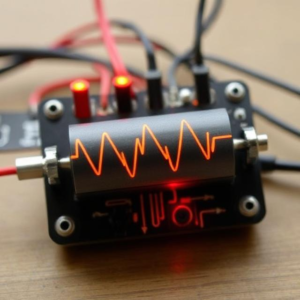An oscillator is a circuit that generates a repeating signal (usually in the form of a sine wave, square wave, or triangle wave) without needing an external signal to drive it. In simple terms, oscillators create their own rhythmic waves.

How Does It Work?
- An oscillator takes DC power (direct current) and converts it into an AC signal (alternating current) that continuously switches on and off.
- It typically involves components like resistors, capacitors, and sometimes transistors or operational amplifiers (Op-Amps).
- The key component is the feedback loop, where part of the output is fed back into the input to sustain the oscillation.
Examples of Oscillators:
- Clock Generators: Used in computers to keep time and synchronize processes.
- Radio Transmitters: Generate the carrier wave that is modulated with audio signals.
- Signal Generators: Create test signals for troubleshooting or testing other equipment.
- Types of Oscillators
There are several types of oscillators, but here are the most common ones:
- RC Oscillator
- RC Oscillators use resistors (R) and capacitors (C) to generate oscillations.
- The RC time constant determines the frequency of the oscillation.
How It Works:
- The capacitor charges and discharges through the resistor, creating a time delay that generates a repetitive waveform.
- Example: A simple Wien Bridge Oscillator is a type of RC oscillator that can produce a sine wave.
Uses:
- Low-frequency oscillators, such as in audio applications, tone generators, or simple radio circuits.
- LC Oscillator
- LC Oscillators use inductors (L) and capacitors (C) to generate oscillations.
- The inductor stores energy in a magnetic field, while the capacitor stores energy in an electric field, creating an alternating current that oscillates.
How It Works:
- The capacitor charges and discharges while the inductor releases energy, and together they create a constant oscillation.
Uses:
- Higher-frequency oscillators, such as in radio and TV transmitters, signal generators, or radio frequency (RF) circuits.
- Crystal Oscillator
- Crystal Oscillators use a quartz crystal (or similar material) to create highly stable and precise oscillations.
- When a voltage is applied to the crystal, it vibrates at a very specific frequency (due to the piezoelectric effect).
How It Works:
- The crystal’s mechanical vibrations generate an electrical signal at a fixed frequency.
Uses:
- Clock circuits in computers, mobile phones, and other devices where precise timing is important.
- Other Key Circuits in Electronics
In addition to oscillators, there are several other important circuits that control how signals behave in an electronic device. Let’s take a look at some of them:
- Amplifiers
An amplifier is a circuit that increases the strength of a signal. This is especially important in audio devices, where small sound signals need to be boosted to drive speakers.
- Types:
- Voltage Amplifiers: Increase the voltage of the input signal.
- Power Amplifiers: Increase both voltage and current, providing more power to drive loudspeakers or other components.
- Operational Amplifiers (Op-Amps): Versatile amplifiers used in many applications like filters, oscillators, and signal processing.
Tags: (VCO), Amplifier, Amplifiers, Amplitude, Audio signals, Audio Systems, capacitor, Charging, circuit design, Clock Pulses, clocks, Colpitts oscillator, Communication Devices, Communication Systems, Computers, crystal oscillator, digital systems, Discharging, Electronic Circuit, Electronic Components, Electronics, Feedback Loop, feedback network, Frequency, Frequency Determining Components, high frequency, Inductor, Laboratory Equipment, LC Oscillator, low frequency, Memristor Oscillator, microcontrollers, Negative Feedback, Oscillation Loop, Oscillation Stability, Oscillator, periodic signal, Phase Shift, phase-locked loop, PLL, Positive Feedback, Power Supply, precision timing, quartz crystal, Radios, RC Oscillator, repeating signal, Resistor, RF Signals, signal generation, signal generators, Signal Reinforcement, sine wave, sound generation, square wave, Synthesizers, timing circuits, triangle wave, TVs, voltage-controlled oscillator, watches, waveform, Waveform Shape, Wien Bridge Oscillator


